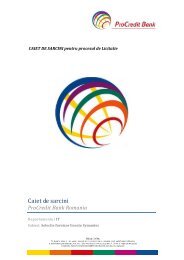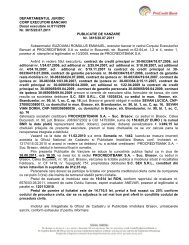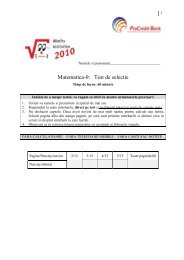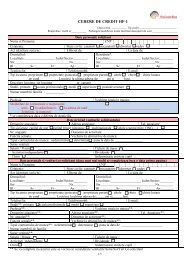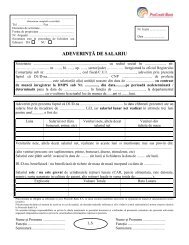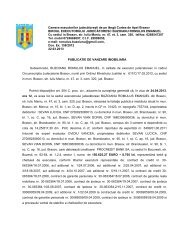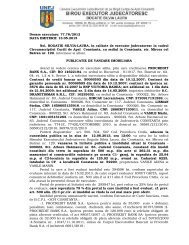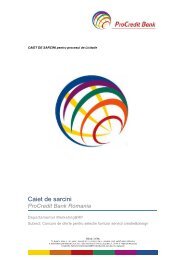Annual Report 2010 - ProCredit Bank
Annual Report 2010 - ProCredit Bank
Annual Report 2010 - ProCredit Bank
You also want an ePaper? Increase the reach of your titles
YUMPU automatically turns print PDFs into web optimized ePapers that Google loves.
Political and Economic Environment<br />
In <strong>2010</strong>, the Romanian economy remained hampered<br />
by the downturn that started in October<br />
2008, albeit less severely. GDP still fell by 1.2%,<br />
but this was a considerable improvement over<br />
2009’s 7.1% decrease. Some economic sectors<br />
continued to decline sharply, such as construction<br />
(-7%) and agriculture (-1%). The country’s<br />
slightly better economic performance in <strong>2010</strong><br />
was mainly due to industrial sector output, which<br />
managed to achieve an increase of 5.8%. However,<br />
the deep recession, paired with austerity<br />
measures, stalled recovery. There was not much<br />
that the government could do to stimulate economic<br />
recovery, as the country has a ballooning<br />
budget deficit and a sub-investment grade rating.<br />
The projections for 2011 are more optimistic,<br />
as the economy is expected to recover and grow<br />
by 1-2% by the end of the year.<br />
During the first weeks of 2011, Romania received<br />
the eighth tranche of the nine-tranche IMF Stand-<br />
By Agreement, bringing the total amount borrowed<br />
from the IMF to EUR 12.2 billion. The disbursement<br />
of the tranches sent positive signals<br />
in the markets, as the government was able to<br />
meet the IMF’s requirements regarding budget<br />
deficit levels and central administration arrears.<br />
The country’s budget deficit in <strong>2010</strong> was 6.5% of<br />
GDP, while the IMF target was set at 6.8%.<br />
In order to meet these requirements, the government<br />
had to take some unpopular measures<br />
during <strong>2010</strong>, such as increasing VAT from 19% to<br />
24% and cutting central administration salaries<br />
by 25%. These measures led to a further contraction<br />
of GDP as well as to political instability,<br />
as the opposition did not support the austerity<br />
measures implemented by the governing party,<br />
which has only a narrow majority in parliament.<br />
Furthermore, Romania’s admittance into the<br />
Schengen Area was postponed, which tarnished<br />
the image of the government both internally<br />
and externally.<br />
On a brighter note, the previous two years of<br />
economic downturn had positive effects on the<br />
current account deficit. During <strong>2010</strong> net imports<br />
continued to decrease, amounting to EUR 6.6 billion<br />
(down from EUR 7.0 billion in 2009). However,<br />
the level of the current account deficit increased<br />
slightly from EUR 5.1 billion to EUR 5.2 billion,<br />
due to the fall in incomes and money transfers<br />
from abroad.<br />
The limited current account deficit, coupled with<br />
IMF and EU funding, nevertheless allowed the<br />
National <strong>Bank</strong> of Romania (NBR) to renew investor<br />
confidence by stabilising the RON against the<br />
major currencies. The inflation rate rose to 7.96%<br />
by year-end, overshooting the National <strong>Bank</strong>’s<br />
target of 3.5%. Due to the macroeconomic developments<br />
of <strong>2010</strong>, Romania will most likely not be<br />
able to adopt the euro in 2015, as was initially<br />
planned. Joining the ERM II is still under debate<br />
and seems to be a distant target.<br />
Financial Sector Developments 1<br />
Management Business Review 13<br />
The number of banks and non-bank financial institutions<br />
in Romania, which stood at 42 and 228,<br />
respectively, was nearly identical to the previous<br />
year; one new, 100% Romanian-owned bank<br />
went into operation. The top five banks held 53%<br />
of total sector assets, while foreign ownership<br />
held 85.1%.<br />
The Romanian banking system did not require<br />
support from the government in <strong>2010</strong>. However,<br />
the shareholders of the banks brought in additional<br />
capital in order to accommodate regulatory<br />
pressures and to compensate for the losses<br />
incurred during <strong>2010</strong>.<br />
Total banking assets contracted for most of <strong>2010</strong>,<br />
but started to pick up again in the second half of<br />
the year due to increased government borrowing,<br />
which grew by 31% to RON 61.6 billion. As a<br />
consequence, total assets as of end-<strong>2010</strong> stood<br />
at RON 341 billion, 3.53% greater than the corresponding<br />
figure for 2009. Lending to the private<br />
sector demonstrated far lower growth of 4.70% 2<br />
to RON 209.3 billion 3 (EUR 48.8 billion) due to<br />
1 Unless otherwise stated, all of the figures cited in the<br />
Financial Sector Developments section were taken from<br />
National <strong>Bank</strong> of Romania, “Statistical <strong>Report</strong>”, December<br />
<strong>2010</strong>.<br />
2 National <strong>Bank</strong> of Romania, “Structure of Deposits and<br />
Loans”, December <strong>2010</strong>.<br />
3 Ibid.




